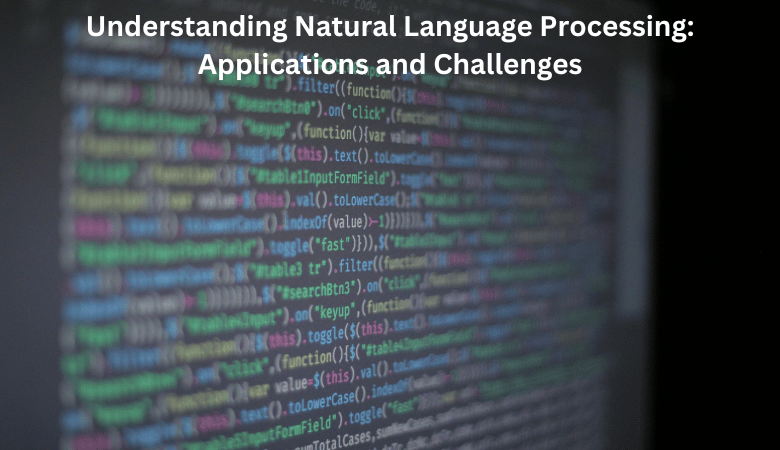Understanding Natural Language Processing: Applications and Challenges

Natural language processing (NLP) is a field of computer science and artificial intelligence involving the study of how computers can understand human language. NLP applications can be used to automatically generate summaries of text, to detect spam emails, to improve search engine results, and to help people with disabilities communicate with others. However, NLP applications can also be challenging to develop, due to the complexities of human language.
What is NLP?
Natural language processing (NLP) is a subfield of linguistics, computer science, information engineering, and artificial intelligence concerned with the interactions between computers and human (natural) languages, in particular how to program computers to process and analyze large amounts of natural language data.
Applications of natural language processing include automated online assistants, chatbots, and machine translation.
NLP is an interdisciplinary field with contributions from computer science, artificial intelligence, linguistics, psychology, and many other disciplines.
The history of NLP generally starts in the 1950s, although work in the area can be found from earlier periods. In 1950, Alan Turing published his famous paper “Computing Machinery and Intelligence”, in which he proposed the famous Turing test as a criterion for determining whether a machine could be said to think.
In 1957, Noam Chomsky published his influential book Syntactic Structures, in which he proposed a formal grammar for describing languages. This work had a major impact on the development of artificial intelligence and linguistics.
In the 1960s and 1970s, many researchers were working on ways to get computers to understand natural language. This work was based on a number of different approaches, including rule-based systems, statistical methods, and artificial neural networks.
In the 1980s and 1990s, there was a renewed interest in artificial intelligence and linguistics, which led to the development of more sophisticated methods for natural language processing. These methods included parsing, semantic analysis, and discourse analysis.
In the early 21st century, there has been a growing interest in natural language processing, with the development of new techniques such as machine learning, deep learning, and data mining.
Natural language processing is a field of computer science, artificial intelligence, and linguistics concerned with the interactions between computers and human (natural) languages.
The main goal of NLP is to develop techniques that enable computers to understand and process human language.
NLP is an interdisciplinary field with contributions from computer science, artificial intelligence, linguistics, psychology, and many other disciplines.
The history of NLP generally starts in the 1950s, although work in the area can be found from
Applications of NLP
The field of natural language processing (NLP) is rapidly evolving. New applications and challenges are constantly being discovered, making it an exciting area of research. In this article, we will explore some of the most popular applications of NLP and discuss some of the challenges associated with each one.
One of the most popular applications of NLP is text classification. This is the process of automatically assigning a label (e.g., positive, negative, spam, etc.) to a piece of text. This is often used for sentiment analysis, where the goal is to determine the overall opinion of a text. Text classification can also be used for spam detection, topic classification, and identifying fake news.
Another common application of NLP is named entity recognition (NER). This is the process of automatically identifying and classifying named entities in a text (e.g., people, places, organizations, etc.). This is useful for tasks such as information extraction and question answering.
Another popular application of NLP is machine translation. This is the process of automatically translating one language to another. This is a difficult task because it requires understanding the meaning of the text, not just the individual words. Machine translation is often used to translate documents or websites into multiple languages.
One of the challenges associated with NLP is the lack of training data. This is because it is often expensive and time-consuming to create labeled data sets for NLP tasks. This is a problem that is slowly being solved with the help of active learning and transfer learning.
Active learning is a technique where the model is given a small amount of labeled data and is then asked to label more data itself. This is a more efficient way of labeling data because the model can focus on the most difficult cases.
Transfer learning is a technique where a model that has been trained on one task is used to help with another task. This is possible because many NLP tasks are similar and share some common features. For example, a model that has been trained on sentiment analysis can be used for topic classification.
Despite the challenges, NLP is an exciting and rapidly evolving field. New applications and challenges are being discovered all the time. With the
Challenges in NLP
Natural language processing (NLP) is a field of computer science, artificial intelligence, and linguistics concerned with the interactions between computers and human (natural) languages. As one of the earliest areas of research in artificial intelligence, NLP deals with the question of how to get computers to do things that only humans can do, such as understanding natural language and recognizing when two pieces of text are saying the same thing.
NLP is difficult because it is hard for computers to understand the complexities of human language. For example, the sentence “The dog didn’t bite the man” can be interpreted in several ways:
The dog didn’t bite the man. (The dog didn’t do anything.)
The dog didn’t bite the man. (The man wasn’t bitten by the dog.)
The dog didn’t bite the man. (Someone else bitten the man, not the dog.)
It is also difficult for computers to understand the context of a sentence. For example, the sentence “I’m going to the store” could mean that the speaker is going to the store to buy something, or it could mean that the speaker is going to work at the store.
NLP is also difficult because there are so many different languages. Each language has its own rules and exceptions, which makes it hard to create a single NLP system that can work for all languages.
Despite these challenges, NLP is a rapidly growing field with many successful applications. NLP systems are used for tasks such as machine translation, automatic summarization, and question answering.
Understanding Natural Language Processing Applications and Challenges
Natural language processing (NLP) is a field of computer science, artificial intelligence, and linguistics concerned with the interactions between computers and human (natural) languages. As its name suggests, NLP is about developing techniques to process and analyze large amounts of natural language data.
NLP is used in a variety of applications, such as text classification, sentiment analysis, topic modeling, named entity recognition, machine translation, and speech recognition. In this blog post, we will focus on understanding NLP applications and challenges.
Applications of NLP
NLP is used in a variety of applications, such as:
Text classification: NLP can be used for text classification, which is the task of assigning a label (e.g., spam or not spam) to a text document. This is typically done using a supervised learning approach, where a training dataset of labeled documents is used to train a classifier. The classifier is then applied to unseen documents to predict the labels.
Sentiment analysis: NLP can also be used for sentiment analysis, which is the task of determining the emotional tone of a text document. This is usually done using a supervised learning approach, where a training dataset of labeled documents is used to train a classifier. The classifier is then applied to unseen documents to predict the labels.
Topic modeling: NLP can be used for topic modeling, which is the task of automatically discovering the topics in a text document. This is typically done using an unsupervised learning approach, where a training dataset of documents is used to train a topic model. The topic model is then applied to unseen documents to discover the topics.
Named entity recognition: NLP can be used for named entity recognition, which is the task of automatically identifying the named entities in a text document. This is typically done using a supervised learning approach, where a training dataset of labeled documents is used to train a classifier. The classifier is then applied to unseen documents to predict the labels.
Machine translation: NLP can be used for machine translation, which is the task of automatically translating a text document from one language to another. This is typically done using a statistical machine translation
The Importance of Natural Language Processing
Natural language processing (NLP) is a field of computer science, artificial intelligence, and linguistics concerned with the interactions between computers and human (natural) languages. As its name suggests, NLP is about developing applications and services that can process and understand human languages.
NLP is a critically important field. It underpins many of the most important applications of artificial intelligence, including machine translation, chatbots, and voice-activated assistants like Siri and Alexa. NLP is also playing an increasingly important role in areas like healthcare, where it is being used to develop applications that can automatically process and interpret medical records.
There are many challenges involved in NLP. One of the biggest is the enormous diversity of human languages. There are over 7000 languages spoken in the world today, and each has its own unique grammar and vocabulary. Another challenge is the ambiguity of natural language. Words can have multiple meanings, and sentences can be open to interpretation.
Despite these challenges, NLP is making great progress. Thanks to advancements in machine learning, NLP algorithms are becoming increasingly accurate. And as more data is collected, NLP systems will only continue to improve.
The importance of NLP can be summed up in one word: communication. NLP is all about enabling computers to communicate with humans in natural, human-like ways. In an increasingly connected world, that is an increasingly important capability.
Applications of Natural Language Processing
Natural Language Processing (NLP) is a field of computer science and artificial intelligence that deals with the interaction between humans and computers. It helps computers to understand, interpret and manipulate human language.
NLP is used to develop applications that can automatically process and make sense of human language. Such applications are used in various fields, including speech recognition, machine translation, information retrieval, question answering, text summarization, sentiment analysis, dialogue systems, chatbots, and predictive text input.
NLP is a complex field, with many different sub-fields and applications. In this article, we will focus on the applications of NLP. We will explore how NLP is used in various fields, and we will also look at some example applications.
1. Speech Recognition
One of the most well-known applications of NLP is speech recognition. This is the process of converting spoken language into text.
Speech recognition systems are used in various applications, such as voice control of devices, hands-free typing, and automatic captioning of videos.
2. Machine Translation
Machine translation is another popular application of NLP. This is the process of translating text from one language to another.
Machine translation systems are used in a variety of applications, such as translating documents, websites, and even speeches.
3. Information Retrieval
Information retrieval is the process of finding information that is relevant to a user’s needs.
NLP is used in information retrieval applications, such as search engines and question-answering systems.
4. Text Summarization
Text summarization is the process of creating a shorter version of a text document.
NLP is used in text summarization applications, such as creating summaries of documents or articles.
5. Sentiment Analysis
Sentiment analysis is the process of determining the emotional tone of a text.
NLP is used in sentiment analysis applications, such as social media monitoring and customer service.
6. Dialogue Systems
Dialogue systems are used to manage conversations between humans and computers.
NLP is used in dialogue systems, such as chatbots, to
Challenges in Natural Language Processing
Natural language processing (NLP) is a subfield of linguistics, computer science, information engineering, and artificial intelligence concerned with the interactions between computers and human (natural) languages, in particular how to program computers to process and analyze large amounts of natural language data.
NLP technologies are used in a wide variety of applications, including text classification, topic modeling, sentiment analysis, named entity recognition, text summarization, machine translation, and question answering.
Despite the successes of NLP technologies, there are still many challenges that need to be addressed. In this blog post, we will discuss some of the challenges in NLP and possible ways to overcome them.
One of the challenges in NLP is the lack of standard evaluation metrics. This makes it difficult to compare the performance of different NLP models and to choose the best model for a particular task. Another challenge is the lack of data. For many NLP tasks, it is difficult to obtain large amounts of training data. This is a particular problem for low-resource languages.
A third challenge is the nature of language itself. Language is a complex and dynamic system, and NLP models often make simplifying assumptions about language that can lead to errors. For example, many NLP models are based on the assumption that all words are independent of each other. However, this is not true in many cases, such as when two words are related by a grammatical relation (e.g., the subject and object of a sentence) or when they are semantically related (e.g., synonyms).
Finally, NLP models are often designed for a specific task or domain. This can make it difficult to adapt them to new tasks or domains. For example, a model that has been trained on news articles may not work well on social media posts.
Despite these challenges, NLP is a rapidly growing field with many exciting applications. We hope that the above discussion will help to raise awareness of the challenges and encourage researchers to develop new methods to overcome them.




